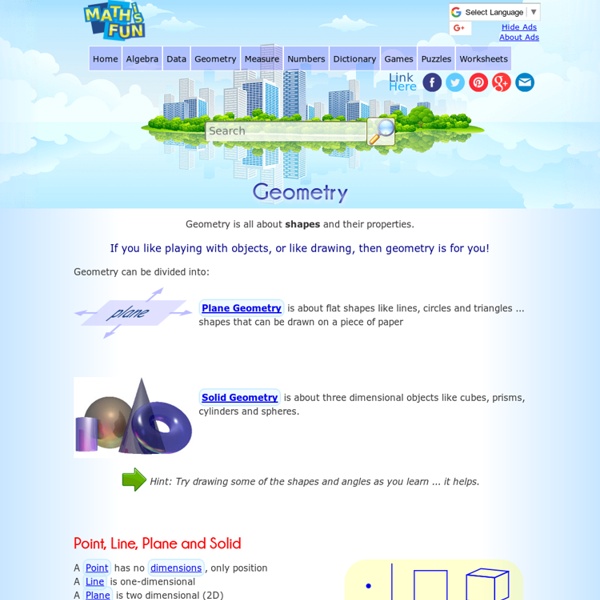3D Shapes . Intro
We live in a three-dimensional world. Every object you can see or touch has three dimensions that can be measured: length, width, and height. The room you are sitting in can be described by these three dimensions. In the world around us, there are many three-dimensional geometric shapes.
Degrees (Angles)
We can measure Angles in Degrees. There are 360 degrees in one Full Rotation (one complete circle around). (Angles can also be measured in Radians) (Note: "Degrees" can also mean Temperature, but here we are talking about Angles) The Degree Symbol: ° We use a little circle ° following the number to mean degrees. For example 90° means 90 degrees One Degree This is how large 1 Degree is The Full Circle A Full Circle is 360° Half a circle is 180° (called a Straight Angle) Quarter of a circle is 90° (called a Right Angle) Measuring Degrees We often measure degrees using a protractor: The normal protractor measures 0° to 180°
Learn To Use Base Ten Blocks at Crewton Ramone's House of Math.
3.NF | Search Results
In this fraction operation and representation activity, students are asked to decide how much of my cake was eaten. Using fraction multiplication (or angle measure if that is where you need an activity) they find out how much someone owes… Read more → Victor Espinoza riding California Chrome The Kentucky Derby was just run. May 17th will be the running of the Preakness horse race. The Preakness is the second race of the Triple Crown. Read more → Act One: Drill bits are measured by the diameter of the bit in inches. Read more → Martin Luther King, Jr. Read more → I make the best, best, really best pie. Read more → In this activity students decide how to divide 2 pizzas amongst 6 adults and 3 pizzas amongst 8 kids. Read more → Hey, the playoffs are about to begin. Read more → Read more → Wildfires are burning in the Sierra Nevada Mountains near Yosemite National Park. Read more → Read more → Time to treat the kids to ratios, proportions, fractions and BIG BURGERS! Read more → Read more → Read more →
Free math games for kids at Fun4theBrain!
Page NEW 1 2 3 View All Lucy is ready to dress the actor and actress from the lates movie, Zomie Prom! Thanks for all the help from her assisstants, Z. Snowy is having tons of fun this winter, but he is a little bit lonely when all the kids go home in the evening. The parents from this town decided that it was too easy getting the candy at the door, so they made an obstacle course around the neighborhood. Security Officer Hubert could use your help down by the docks. Come fight 'tis new platform battle featurin' a ruckas band 'o pirates! Muddy lives in the marsh in Murb. Sasha delivers all the orders for Murb Grocery. Tory Tools has opened his shop! Those crazy penguins from Cone Crazy are back again in a new game - Flurry of Flavors. You have gotten a job as an marine photographer! The crazy crows have stolen Lucky's coins and luck. There is a large group of reindeer that want to get some delicious cookies from your Reindeer Café. It is lunchtime at the Alien Academy. Come help Dr.
Paper Models of Polyhedra
Binary Game
Skip to Content | Skip to Footer Cisco Binary Game The Cisco Binary Game is the best way to learn and practice the binary number system.
Angles Around a Point Add to 360
Angles around a point will always add up to 360 degrees. The angles above all add to 360° 53° + 80° + 140° + 87° = 360° Because of this, we can find an unknown angle. Example: What is angle "c"? To find angle c we take the sum of the known angles and take that from 360°
Triangles Contain 180 Degrees
Try it yourself (drag the points): We can use that fact to find a missing angle in a triangle: Example: Find the Missing Angle "C" This is a proof that the angles in a triangle equal 180°: The top line (that touches the top of the triangle) is running parallel to the base of the triangle. So: angles A are the same angles B are the same And you can easily see that A + C + B does a complete rotation from one side of the straight line to the other, or 180°
Fact Family Worksheets
Welcome to the fact family worksheets page at Math-Drills.com! This page includes Fact family worksheets including addition and subtraction relationships, and multiplication and division relationships. Addition and Subtraction Relationships Once students understand the relationship between addition and subtraction, subtraction becomes less of a mystery, and they are able to complete more complex problems. Multiplication and Division Relationships Multiplication and division have an inverse relationship, so if a student knows that 9 × 8 = 72 then they should also know the answer to 72 ÷ 8.



